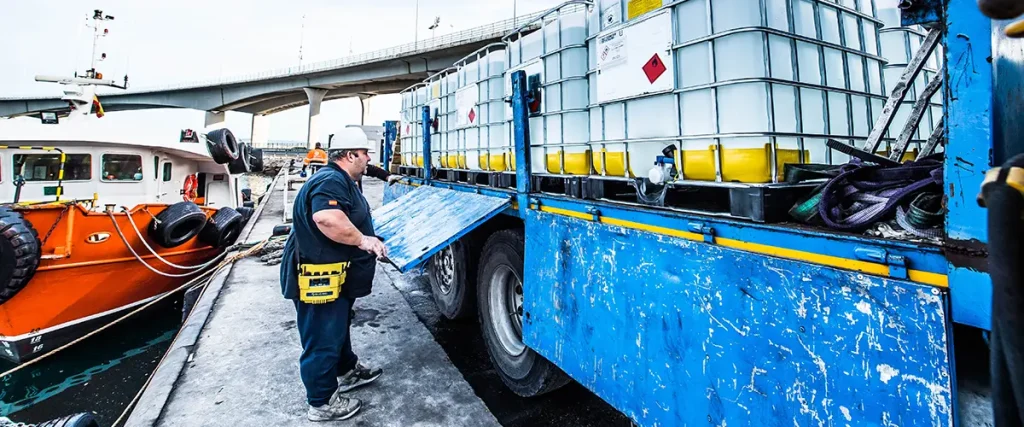In the world of maritime logistics, accuracy and clarity in documentation are essential, especially when handling liquid bulk cargo like crude oil, refined petroleum, chemicals, and oils. A cargo manifest is one of the most important documents for ensuring efficient, compliant global trade. At Ibérica Marítima, as a ship agency, we know just how vital this tool is for seamless operations.
In this guide, we explain the full cargo manifest shipping definition in the context of tanker shipping, explore its various types and uses, and show how our team can support your logistics from port to port.
Definition and purpose of a cargo manifest
A cargo manifest, sometimes called a “shipping manifest”, is a structured document listing every item loaded onto a transport. This includes detailed records of liquid bulk cargo volumes, classifications, and handling requirements. It is essential for customs clearance, port coordination, and transparent communication across the supply chain.
What information does a cargo manifest include?
A cargo manifest typically includes key information such as the details of the shipper and consignee, the product name and classification, the quantity and weight of the cargo (and temperature, when applicable), the ports of origin and destination, as well as tank allocation and ship’s stowage plan and booking references and document identifiers.
Why is it important in global logistics?
A well-prepared cargo manifest reduces delays, streamlines inspections, and avoids miscommunication. A precise cargo manifest enables port authorities, terminal operators, and customs to coordinate operations safely—especially for regulated cargo like hazardous chemicals or petroleum products.

Types of cargo manifests
- Tanker manifest: Core document for all cargoes loaded or discharged, with details required by both terminal and customs.
- Dangerous goods manifest: Details hazardous materials to comply with safety regulations and avoid handling risks.
- Customs and regulatory manifests: Submitted to customs authorities and often linked to digital customs systems for inspection and clearance.
Cargo manifest vs. related documents
To better understand the role of a cargo manifest, here’s how it compares to other logistics documents:
| Document Type | Purpose | Key Differences |
| Cargo Manifest | Lists all goods on a transport vehicle | Focuses on shipment tracking and customs review |
| Bill of Lading | Contract of carriage between shipper and carrier | Acts as receipt, legal contract, and document of title |
| Packing List | Details package contents | Specific to individual shipments, not overall cargo |
| Shipping Label | Identifies shipping details on packages | Applied physically; not a summary of the full shipment |
| Commercial Invoice | Shows transaction details and prices | Used for customs valuation and financial processing |
Key components of a tanker shipping
- Shipper and consignee details: Accurate names and contact information for both the sender and recipient.
- Goods description and classification: Item names, quantities, and Harmonized System (HS) codes.
- Quantity, weight, and volumes: Essential for proper cargo handling and stowage planning. Including observed volume, temperature-corrected volume, and density.
- Tank allocation: Which tanks carry each product.
- Routing and transport details: Includes origin, destination, and load and discharge points.
- Booking reference and document numbers: Used to track the shipment through each leg of the journey.
Who uses cargo manifests and why?
Shipping lines, freight forwarders, trading operators and brokers
To organize, load, and track shipments.
Customs authorities
To verify contents and ensure import/export compliance.
Importers and exporters
To check shipment details against purchase orders or contracts.
Warehouse and logistics operators
To prepare for receiving, storing, and dispatching cargo.
Can cargo manifests be changed?
Pre-shipment vs. post-shipment updates
Changes can be made before the shipment departs. Post-shipment edits require formal documentation and may involve customs or carrier approval.
Legal implications and documentation
Inaccuracies can lead to fines or shipment delays. Any changes must be properly logged and justified.
Example of a cargo manifest
Here’s a basic shipping manifest example:
MT Petrochem 12 loaded 8,000 MT of Gasoline UN1203, 5,000 MT of MTBE, and 3,000 MT of Sunflower Oil—distributed across tanks 1P to 4C. Volumes and densities measured by independent surveyor. Discharging at Valencia and Malta.
Frequently asked questions about cargo manifests
Are tanker cargo manifests public records?
Not always. While some countries publish cargo manifest data for transparency, others treat it as confidential for security or commercial reasons.
What happens if there are discrepancies?
Discrepancies must be reported immediately. Depending on the nature of the issue, customs may impose penalties, delay cargo, or require formal corrections.
How long must cargo manifests be retained?
Retention requirements vary by country, but most regulations require keeping cargo manifests for 3 to 7 years especially for hazardous or high-value cargo.
How can a shipping agent like Ibérica Marítima assist in case of discrepancies in a cargo manifest?
Our team offers hands-on assistance to prepare, review, and correct cargo manifests for tanker shipments. We work closely with surveyors, whose reports are key to validating the declared quantities and the quality of liquid bulk cargo —such as crude oil, refined products, chemicals, or edible oils. Their input ensures the cargo manifest reflects accurate volume measurements, product specifications, and compliance data.
At Ibérica Marítima, we combine over 60 years of experience with real-time knowledge of port requirements and vessel movements. Whether you’re managing a spot market voyage, coordinating complex discharges, or responding to customs queries, our team ensures that every document is aligned, accurate, and fully supported.
With Ibérica Marítima, your cargo is in expert hands—ready to move, with confidence.


